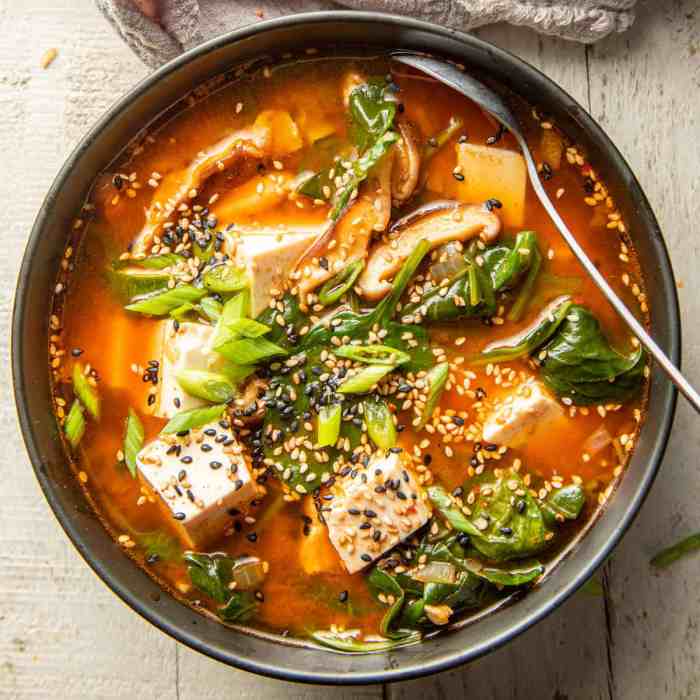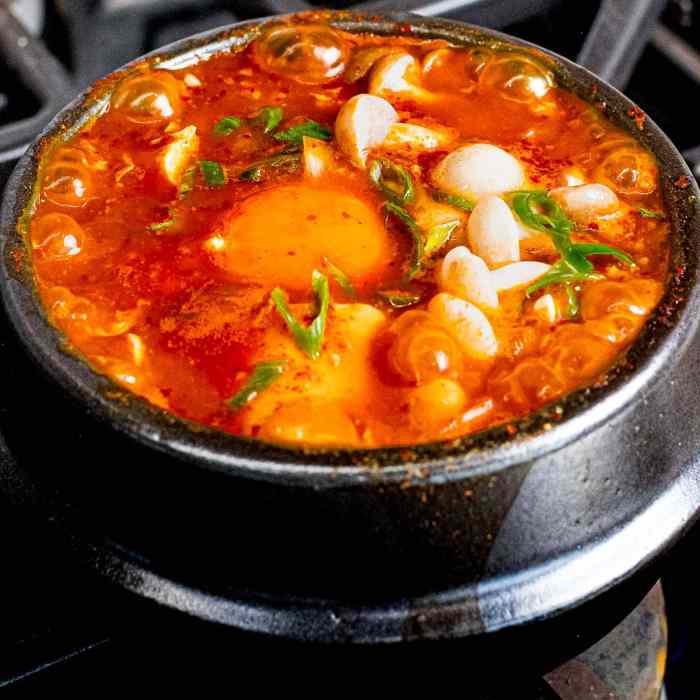Korean Tofu Soup (Sundubu Jjigae): A Culinary Delight: Recipe For Korean Tofu Soup
Recipe for korean tofu soup – Sundubu Jjigae, or soft tofu stew, is a beloved Korean dish known for its rich, savory broth and tender tofu. Its popularity stems from its simple yet deeply satisfying flavor profile, quick cooking time, and adaptable nature, allowing for diverse culinary interpretations. This exploration delves into the history, preparation, variations, and cultural significance of this iconic Korean comfort food.
Introduction to Korean Tofu Jjigae (Sundubu Jjigae)
Sundubu Jjigae’s origins trace back to the Joseon Dynasty, though its precise history remains somewhat elusive. What distinguishes it from other tofu soups is its use of very soft, almost silken tofu, which cooks quickly in a bubbling, spicy broth. The broth itself is typically seasoned with gochujang (Korean chili paste), gochugaru (Korean chili flakes), and doenjang (fermented soybean paste), creating a characteristically vibrant and spicy flavor.
In Korean culture, Sundubu Jjigae is often enjoyed as a hearty breakfast or a quick and satisfying meal, reflecting its practicality and widespread appeal.
Essential Ingredients and Their Variations
A basic Sundubu Jjigae recipe relies on a few key ingredients, allowing for easy customization. Substituting certain ingredients can significantly alter the final taste, offering opportunities for culinary exploration.
| Ingredient | Common Substitution | Impact on Flavor |
|---|---|---|
| Soft Tofu (Sundubu) | Firm or extra-firm tofu (less ideal) | Firmer tofu results in a less delicate texture and may not absorb the broth as well. |
| Gochujang (Korean Chili Paste) | Gochugaru (Korean Chili Flakes) or other chili pastes | Adjusting the amount to achieve desired spice level. Gochugaru provides a different heat profile compared to gochujang’s depth of flavor. |
| Doenjang (Fermented Soybean Paste) | Miso paste (Japanese) | Miso offers a slightly sweeter and less pungent umami flavor compared to doenjang. |
| Seafood or Meat (optional) | Various protein sources like kimchi, mushrooms, or vegetables | Adds protein and depth of flavor; significantly alters the overall character of the soup depending on the choice. |
Step-by-Step Cooking Process
Preparing Sundubu Jjigae is a straightforward process, requiring careful attention to detail to achieve the ideal consistency and flavor.
- Heat a pot and add oil. Sauté aromatics (garlic, onion, etc.) until fragrant.
- Add gochujang and doenjang, stirring until well combined and slightly browned.
- Pour in the broth (dashi or water), and bring to a simmer. Add any additional ingredients such as seafood or meat.
- Gently add the soft tofu, ensuring it doesn’t break apart. Simmer for a few minutes until heated through.
- Season with salt, pepper, and other desired spices. Adjust consistency by adding more broth if needed.
- Serve immediately in a heated bowl, garnished as desired.
Flavor Profiles and Variations
The spiciness of Sundubu Jjigae can be easily adjusted by controlling the amount of gochujang and gochugaru. Regional variations exist, with some versions incorporating seafood like clams or mussels, while others feature kimchi or mushrooms for added complexity.
Adding ingredients like seaweed, green onions, or a splash of sesame oil can further enhance the overall flavor profile.
Serving Suggestions and Accompaniments
Sundubu Jjigae is best served piping hot, allowing the diner to fully appreciate the warmth and richness of the broth. A simple garnish of green onions and a sprinkle of sesame seeds adds a touch of elegance. It pairs well with steamed rice, various banchan (Korean side dishes), and kimchi.
The contrasting textures and flavors of the soft tofu, spicy broth, and accompanying side dishes create a balanced and satisfying culinary experience.
Crafting a delicious Korean tofu soup involves a delicate balance of flavors and textures. For a different kind of comforting soup, you might consider checking out this panera chicken noodle soup recipe , which offers a hearty alternative. Returning to our Korean tofu soup, remember that the quality of the broth is paramount to its success.
Nutritional Information and Health Benefits

Source: connoisseurusveg.com
Sundubu Jjigae is a relatively healthy and nutritious dish, packed with protein from the tofu and potential health benefits from the various ingredients.
- High in protein
- Good source of iron (from the tofu and potential meat/seafood additions)
- Rich in isoflavones (from the tofu)
- Contains various vitamins and minerals depending on added ingredients
Troubleshooting Common Issues, Recipe for korean tofu soup
Overly thick or thin consistency is a common problem. Too thick? Add more broth. Too thin? Simmer longer to reduce the liquid.
To prevent the tofu from breaking, add it gently towards the end of the cooking process and avoid stirring too vigorously.
Visual Representation of the Dish

Source: drivemehungry.com
A perfectly prepared Sundubu Jjigae presents a vibrant and inviting appearance. The rich, reddish-orange broth is punctuated by the creamy white of the soft tofu. Any added seafood or vegetables add visual interest and texture. Served in a warm bowl, garnished with a scattering of green onions and a sprinkle of sesame seeds, it’s a dish that appeals to both the palate and the eye.
Popular Questions
Can I use frozen tofu?
While fresh tofu is ideal, you can use frozen tofu. Thaw it completely and press out excess water before using.
What if my soup is too thick/thin?
Add more broth for thinner consistency, or simmer uncovered to reduce liquid for thicker consistency.
How can I prevent the tofu from breaking?
Gently add the tofu towards the end of cooking and avoid stirring vigorously.
Are there vegetarian/vegan options?
Yes, simply omit any seafood or meat ingredients for a vegetarian or vegan version.
